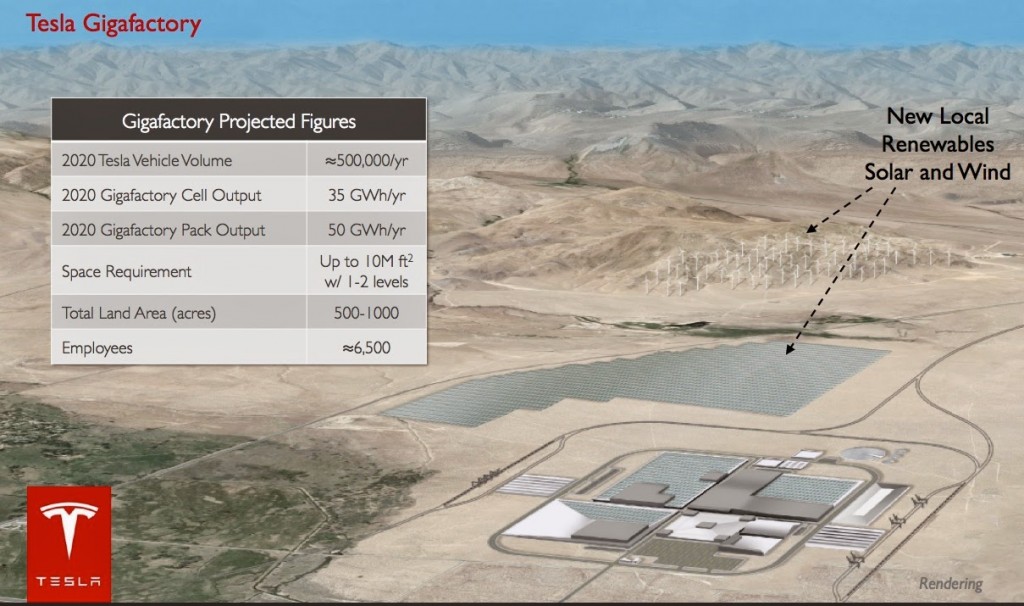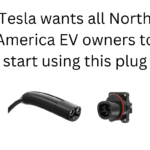Tesla Motors and Panasonic today announced the expected agreement for joint operation of the Gigafactory. Under the agreement, Tesla will own the facility and Panasonic will be the primary partner occupying about half the space. Several companies will be on site manufacturing precursor materials, that Panasonic puts together to make cylindrical lithium-ion cells, that Tesla puts together into battery packs.
I posted a longer explanation on examiner.com![]() .
.
Here’s the press release. Later today Tesla Motors will hold its quarterly financial results conference call. I’m sure the Q&A section will be highly interesting.
PANASONIC AND TESLA SIGN AGREEMENT FOR THE GIGAFACTORY
THURSDAY, JULY 31, 2014
OSAKA, Japan / PALO ALTO, USA, July 31, 2014 – Panasonic Corporation and Tesla Motors, Inc. have signed an agreement that lays out their cooperation on the construction of a large-scale battery manufacturing plant in the United States, known as the Gigafactory.
According to the agreement, Tesla will prepare, provide and manage the land, buildings and utilities. Panasonic will manufacture and supply cylindrical lithium-ion cells and invest in the associated equipment, machinery, and other manufacturing tools based on their mutual approval. A network of supplier partners is planned to produce the required precursor materials. Tesla will take the cells and other components to assemble battery modules and packs. To meet the projected demand for cells, Tesla will continue to purchase battery cells produced in Panasonic’s factories in Japan. Tesla and Panasonic will continue to discuss the details of implementation including sales, operations and investment.
The Gigafactory is being created to enable a continuous reduction in the cost of long range battery packs in parallel with manufacturing at the volumes required to enable Tesla to meet its goal of advancing mass market electric vehicles. The Gigafactory will be managed by Tesla with Panasonic joining as the principle partner responsible for lithium-ion battery cells and occupying approximately half of the planned manufacturing space; key suppliers combined with Tesla’s module and pack assembly will comprise the other half of this fully integrated industrial complex.
JB Straubel, Chief Technical Officer and Co-founder of Tesla Motors said: “the Gigafactory represents a fundamental change in the way large scale battery production can be realized. Not only does the Gigafactory enable capacity needed for the Model 3 but it sets the path for a dramatic reduction in the cost of energy storage across a broad range of applications.”
Yoshihiko Yamada, Executive Vice President of Panasonic, added, “We have already engaged in various collaborative projects with Tesla toward the popularization of electric vehicles. Panasonic’s lithium-ion battery cells combine the required features for electric vehicles such as high capacity, durability and cost performance. And I believe that once we are able to manufacture lithium-ion battery cells at the Gigafactory, we will be able to accelerate the expansion of the electric vehicle market.”
Cost reductions will be achieved through optimized manufacturing processes driven by economies of scale previously unobtainable in battery cell and pack production. Further price reductions are achieved by manufacturing cells that have been optimized for electric vehicle design, both in size and function, by co-locating suppliers on-site to eliminate packaging, transportation & duty costs and inventory carrying costs, and by manufacturing at a location with lower utility and operating expenses.
The Gigafactory will produce cells, modules and packs for Tesla’s electric vehicles and for the stationary storage market. The Gigafactory is planned to produce 35GWh of cells and 50GWh of packs per year by 2020. Tesla projects that the Gigafactory will employ about 6,500 people by 2020.
Panasonic
http://panasonic.net/

http://panasonic.net/
Tesla Motors
http://www.teslamotors.com/blog-and-press-releases

http://www.teslamotors.com/blog-and-press-releases
- Highway design could decrease death and injury risk, if “we” chose smarter designs - March 28, 2015
- GM really did trademark “range anxiety”, only later to abandon that mark - March 25, 2015
- US Government releases new regulations on hydraulic fracturing, that some call “toothless” - March 20, 2015
- Tesla Motors magic pill to solve range anxiety doesn’t quite instill range confidence - March 19, 2015
- Update on Galena IL oil train – 21 cars involved, which were the supposedly safer CP1232 design - March 7, 2015
- Another oil bomb train – why are they shipping crude oil by train? – Symptoms of fossil fuel addiction - March 6, 2015
- Chevron relinquishes fracking in Romania, as part of broader pull-out from Eastern European fracking operations - February 22, 2015
- Answer anti- electric car articles with truth and pride – truth outshines all distortions - February 19, 2015
- Apple taking big risk on developing a car? Please, Apple, don’t go there! - February 16, 2015
- Toyota, Nissan, Honda working on Japanese fuel cell infrastructure for Japanese government - February 12, 2015










